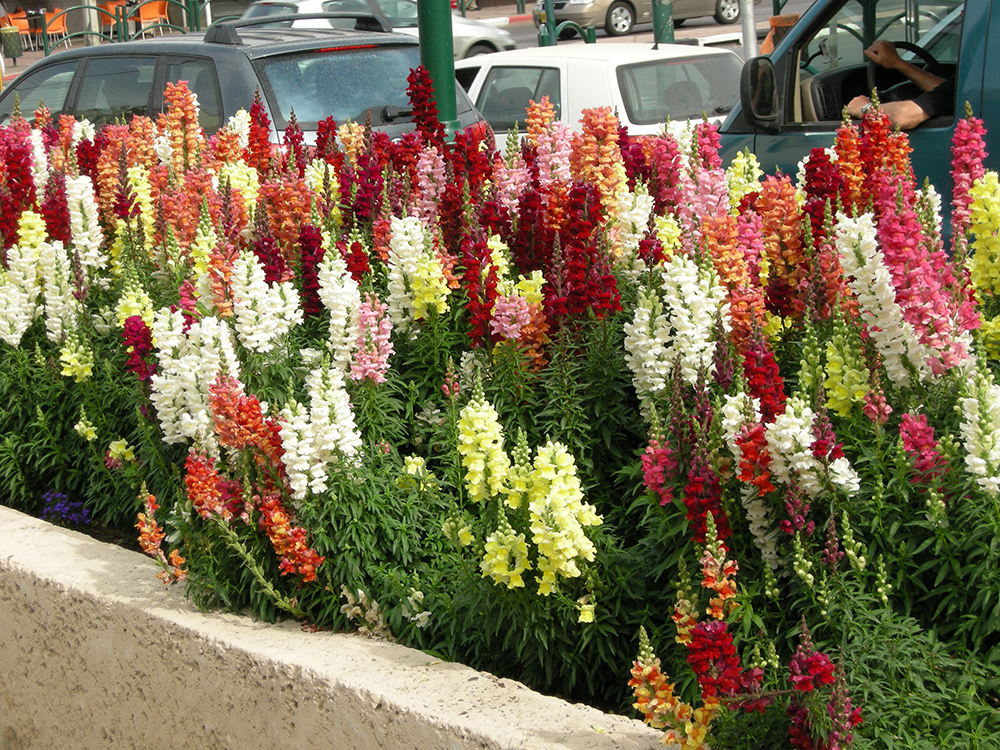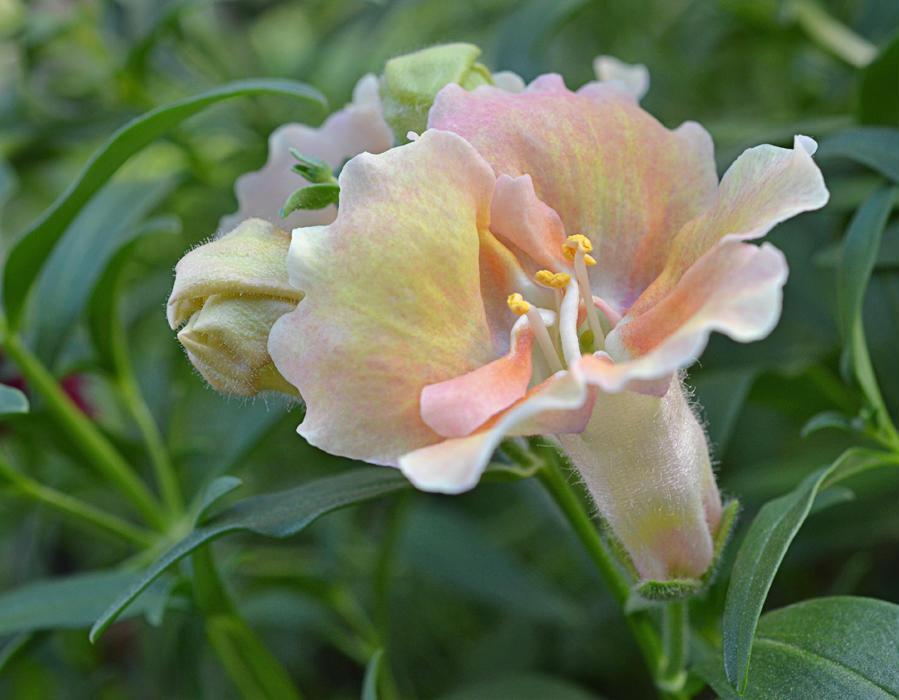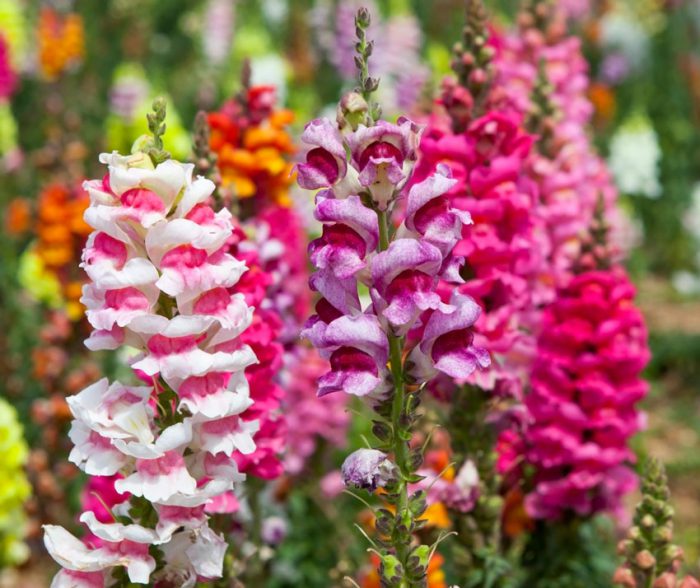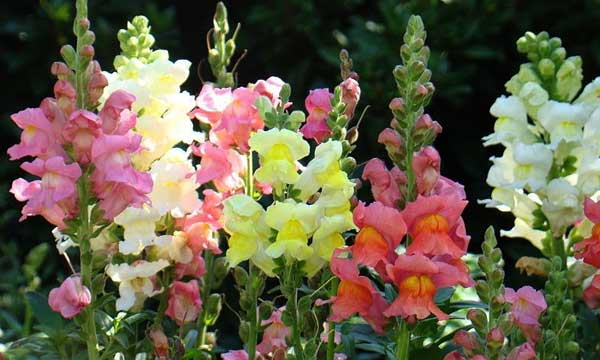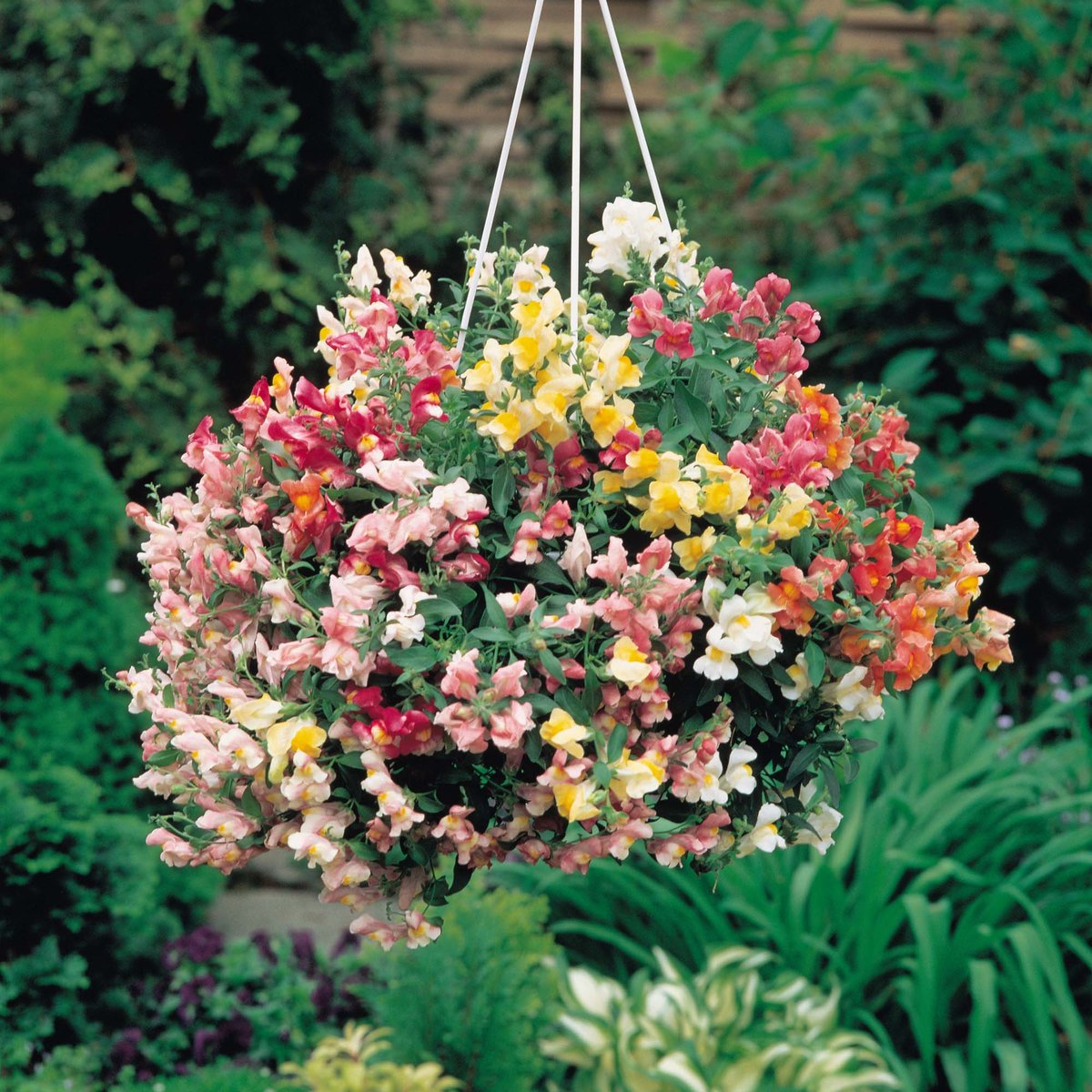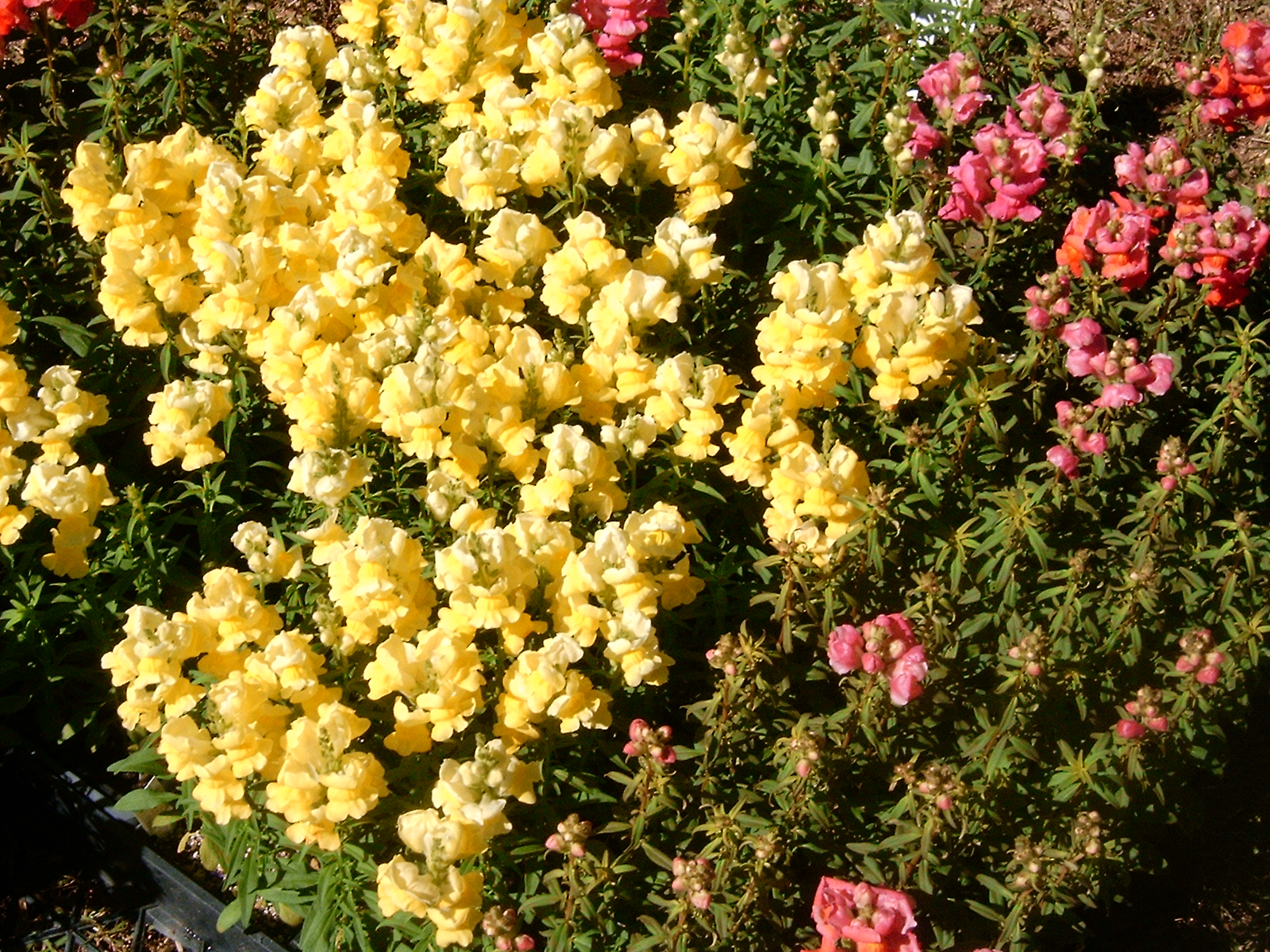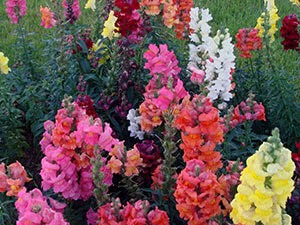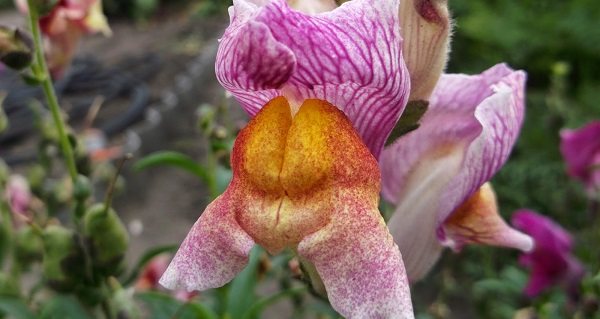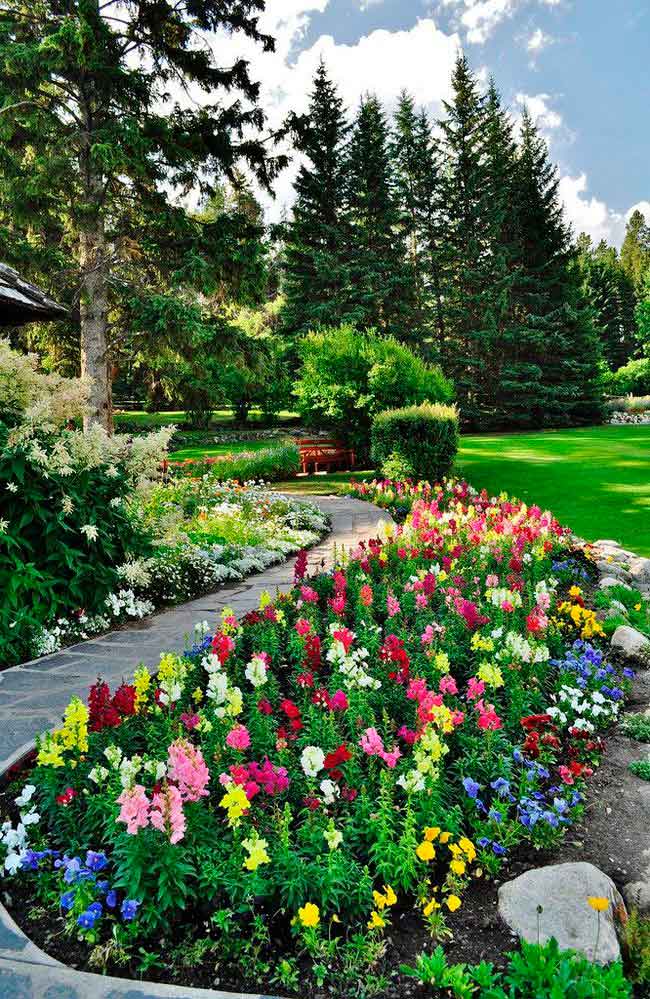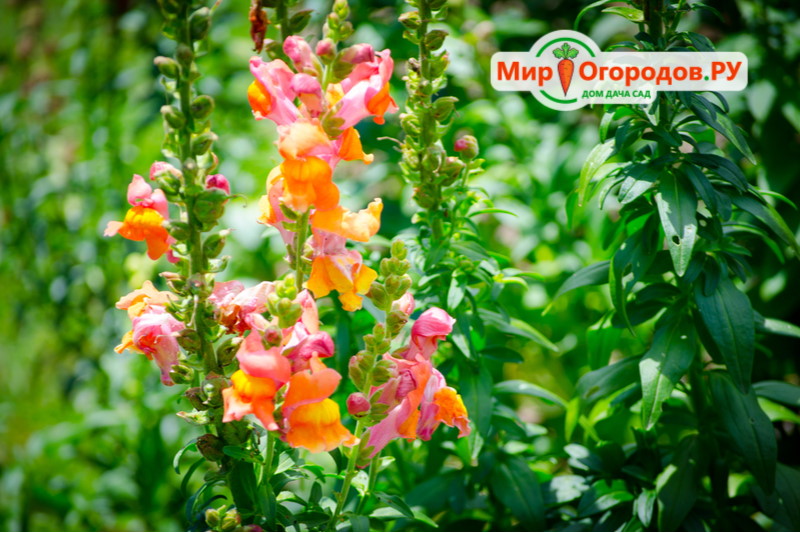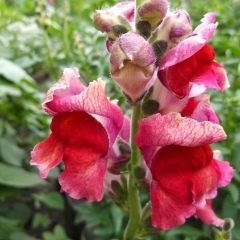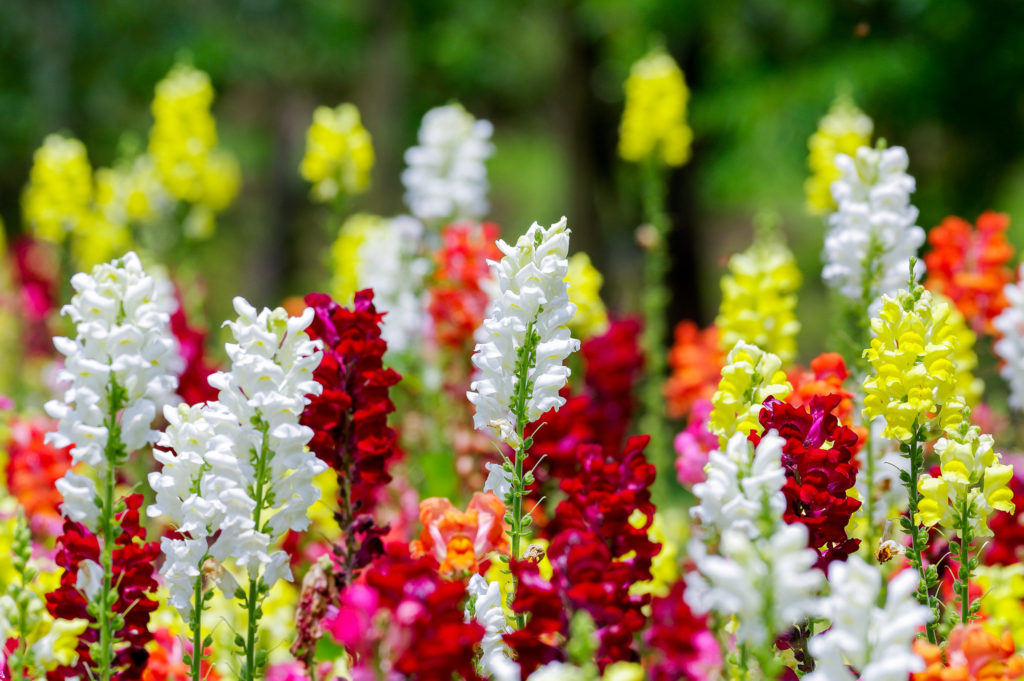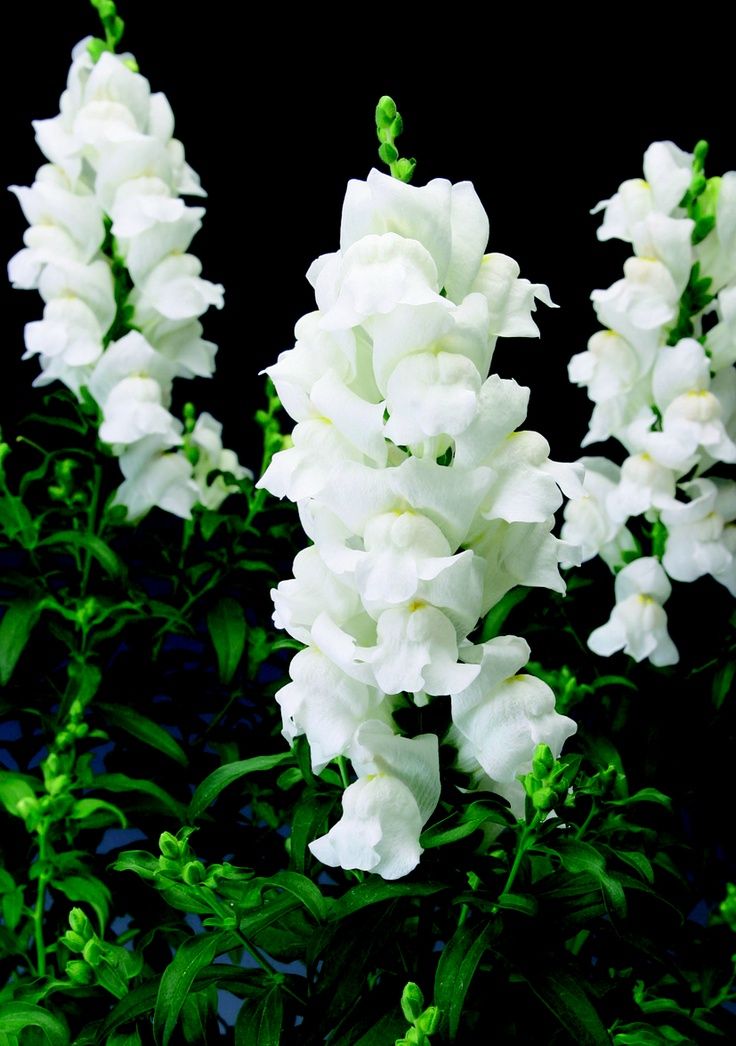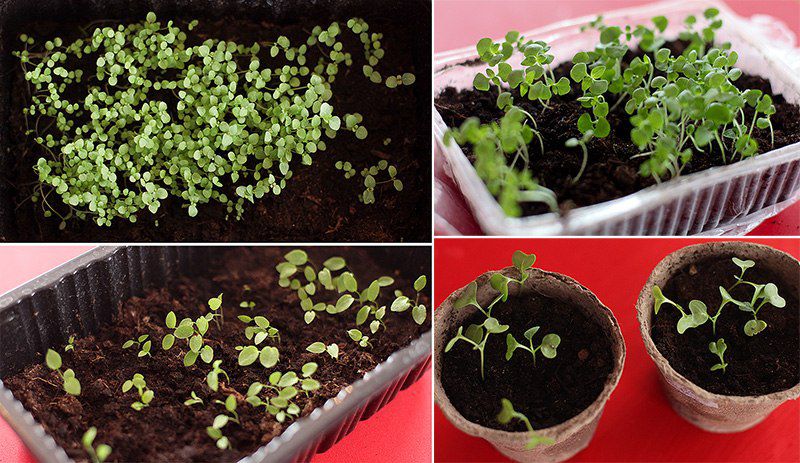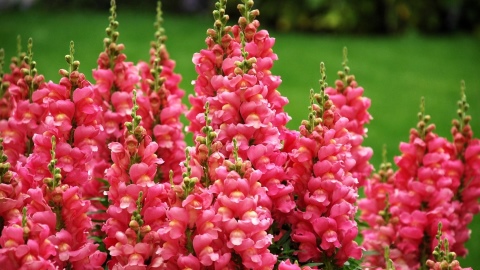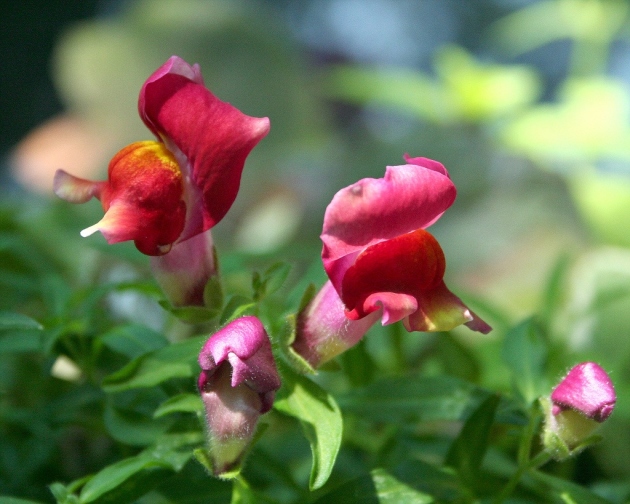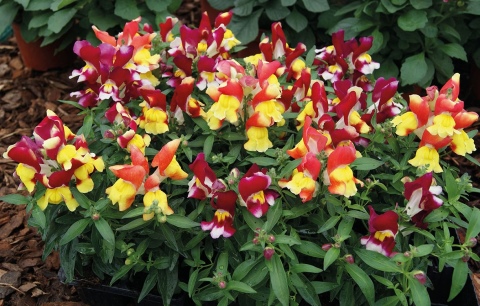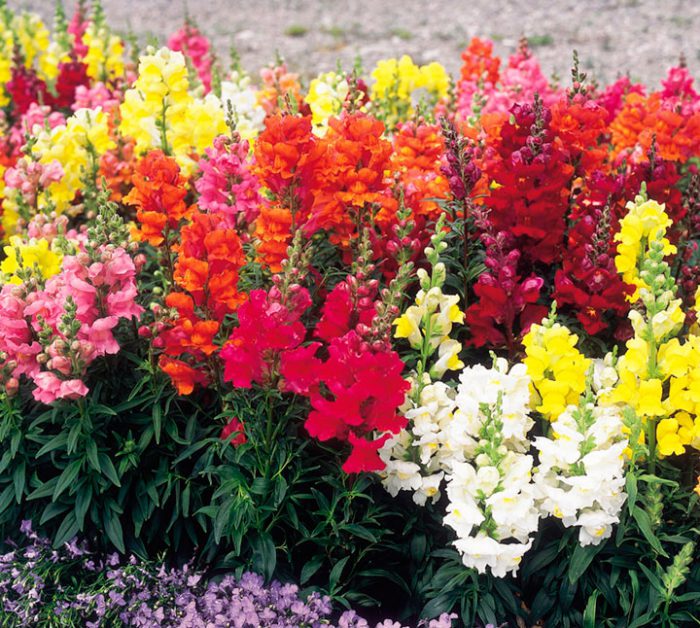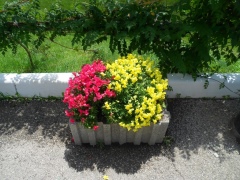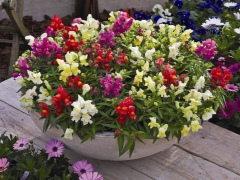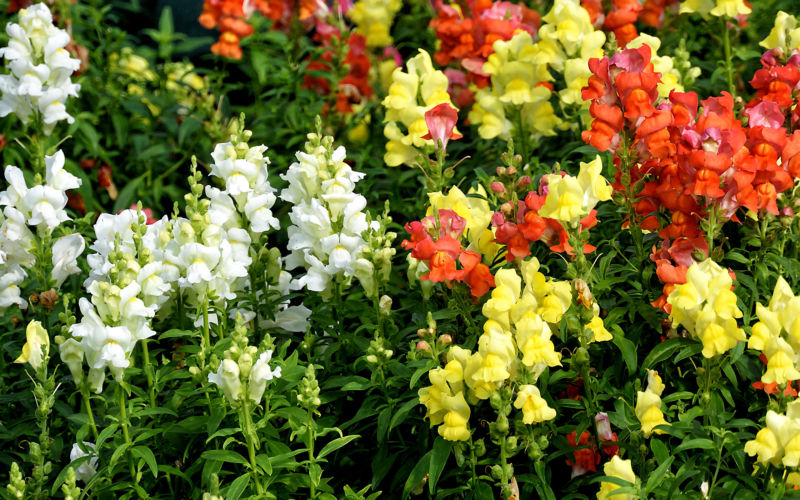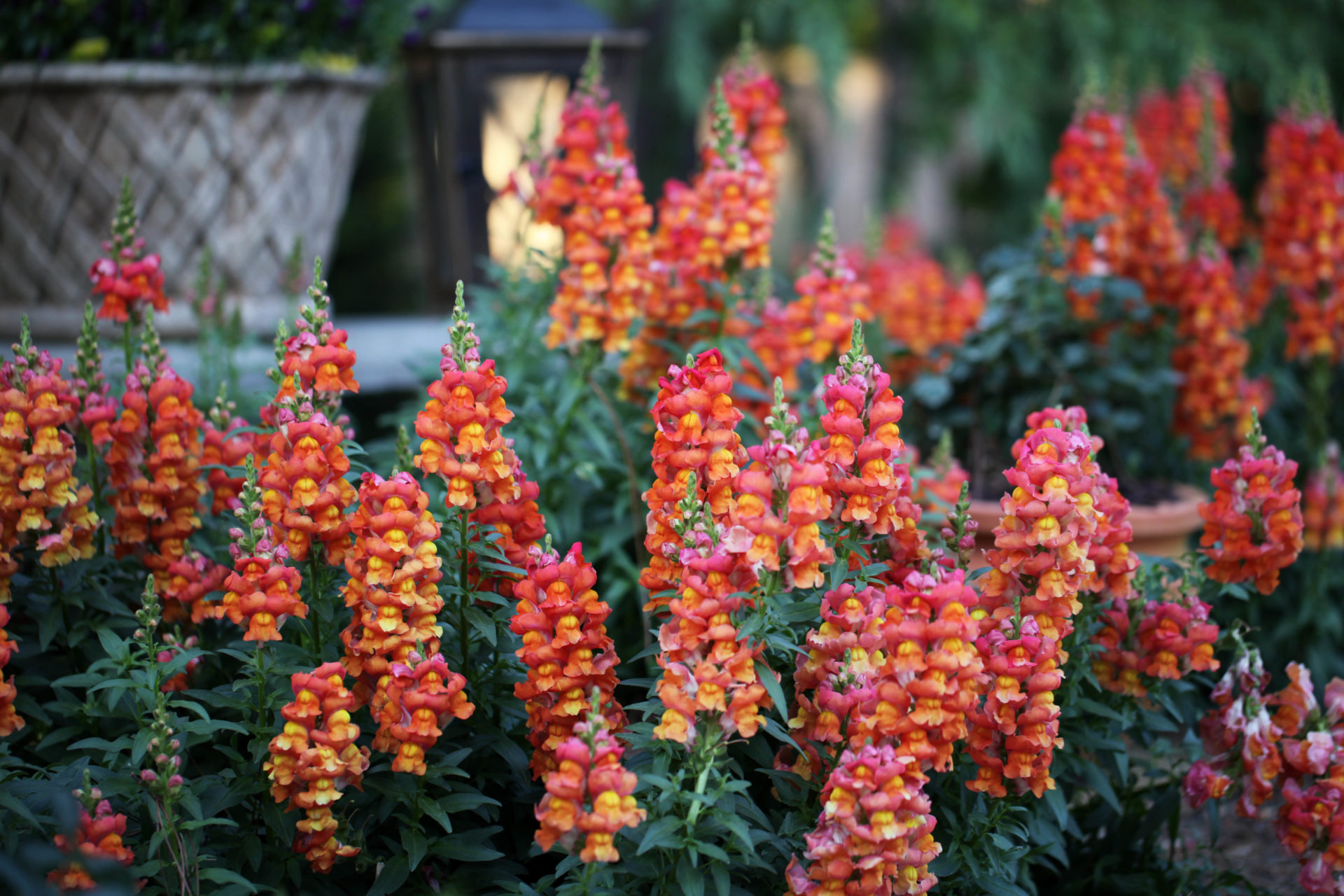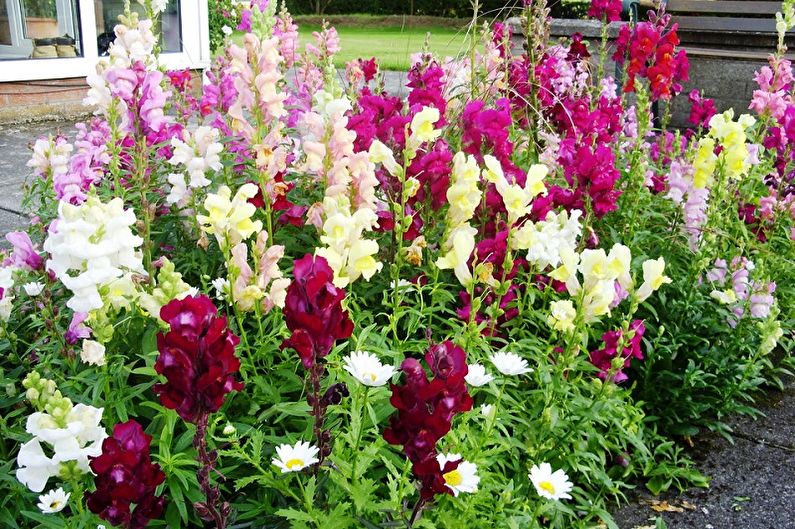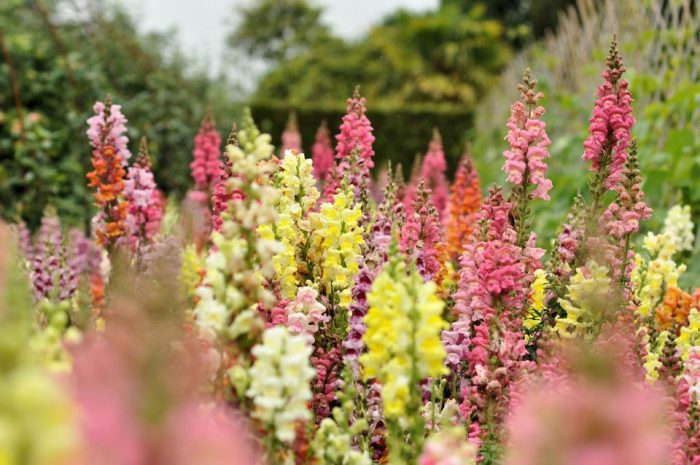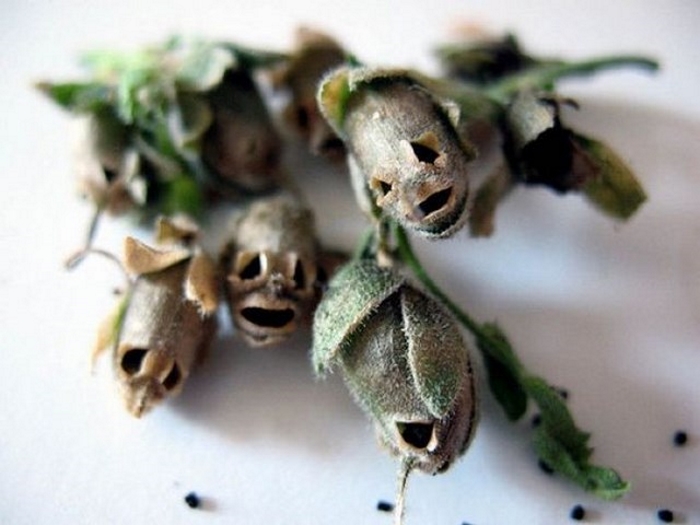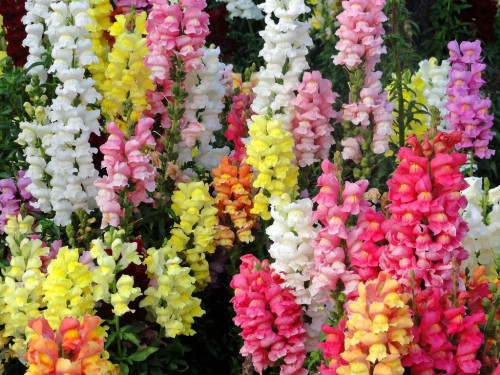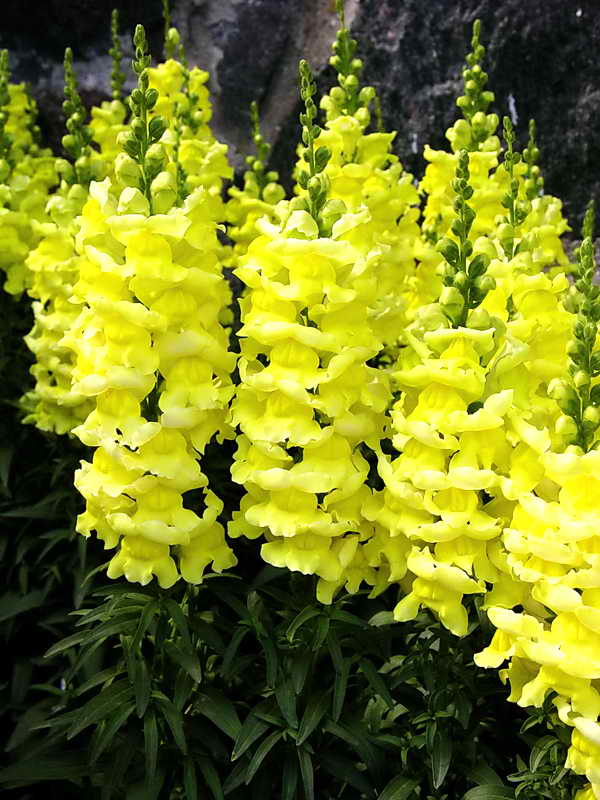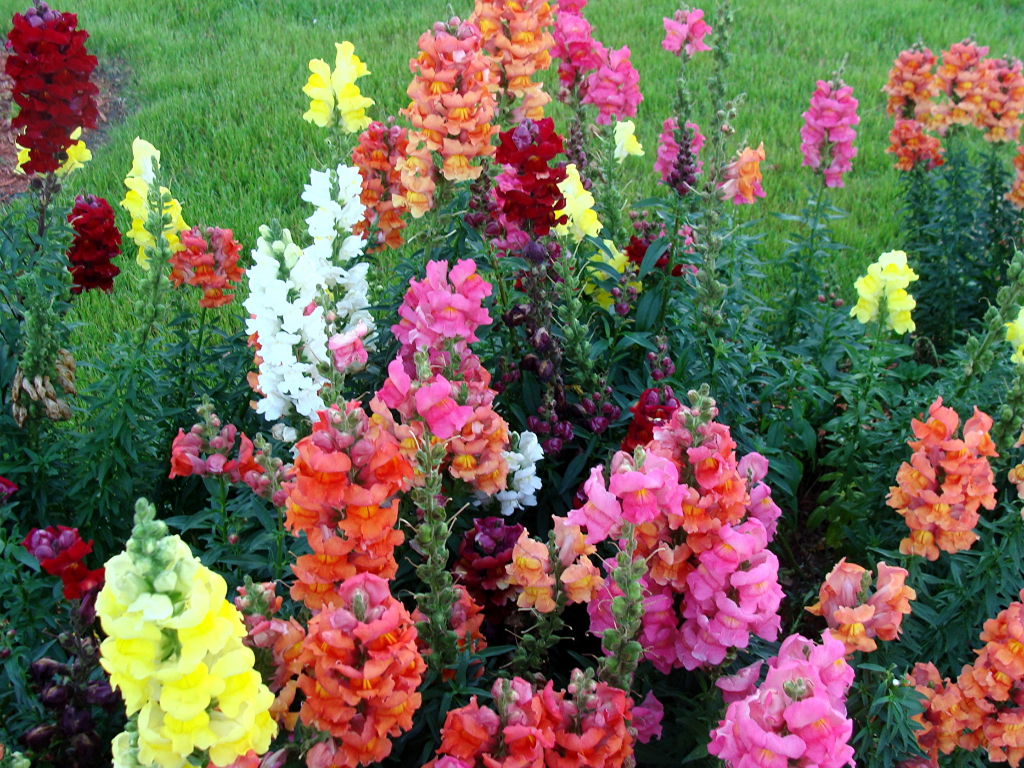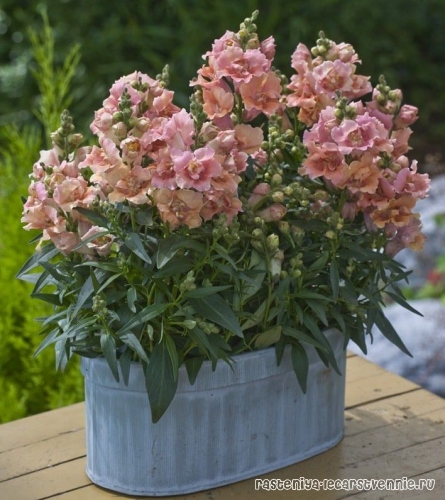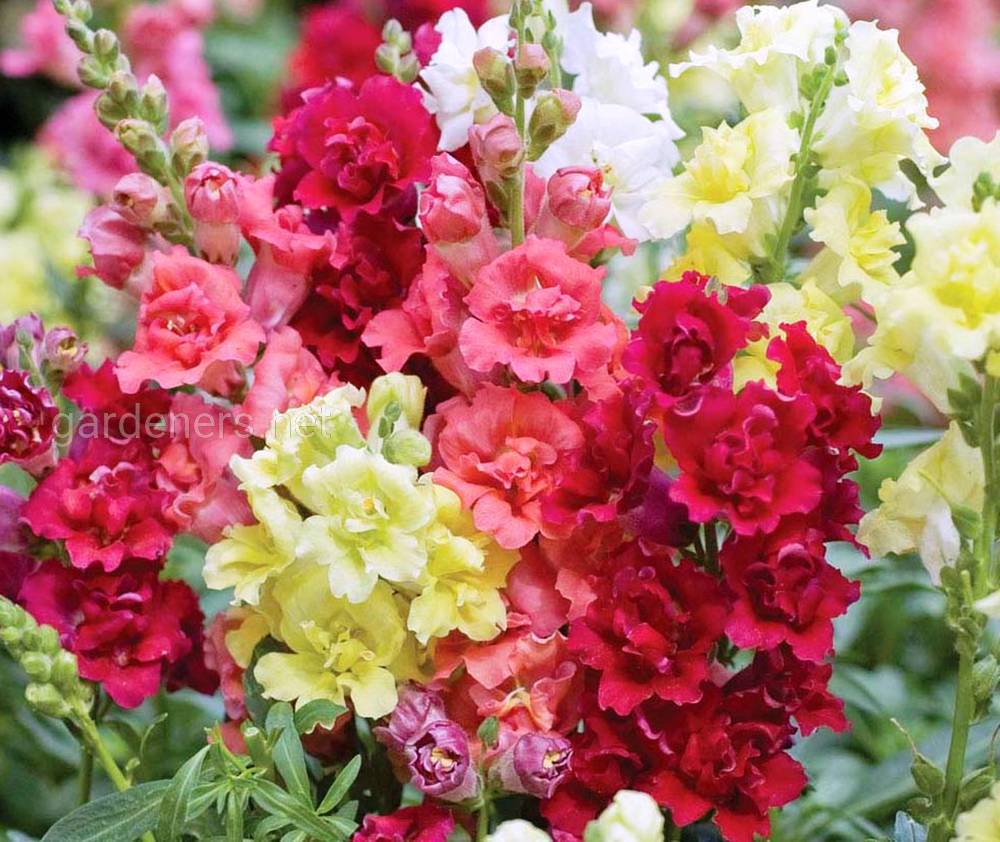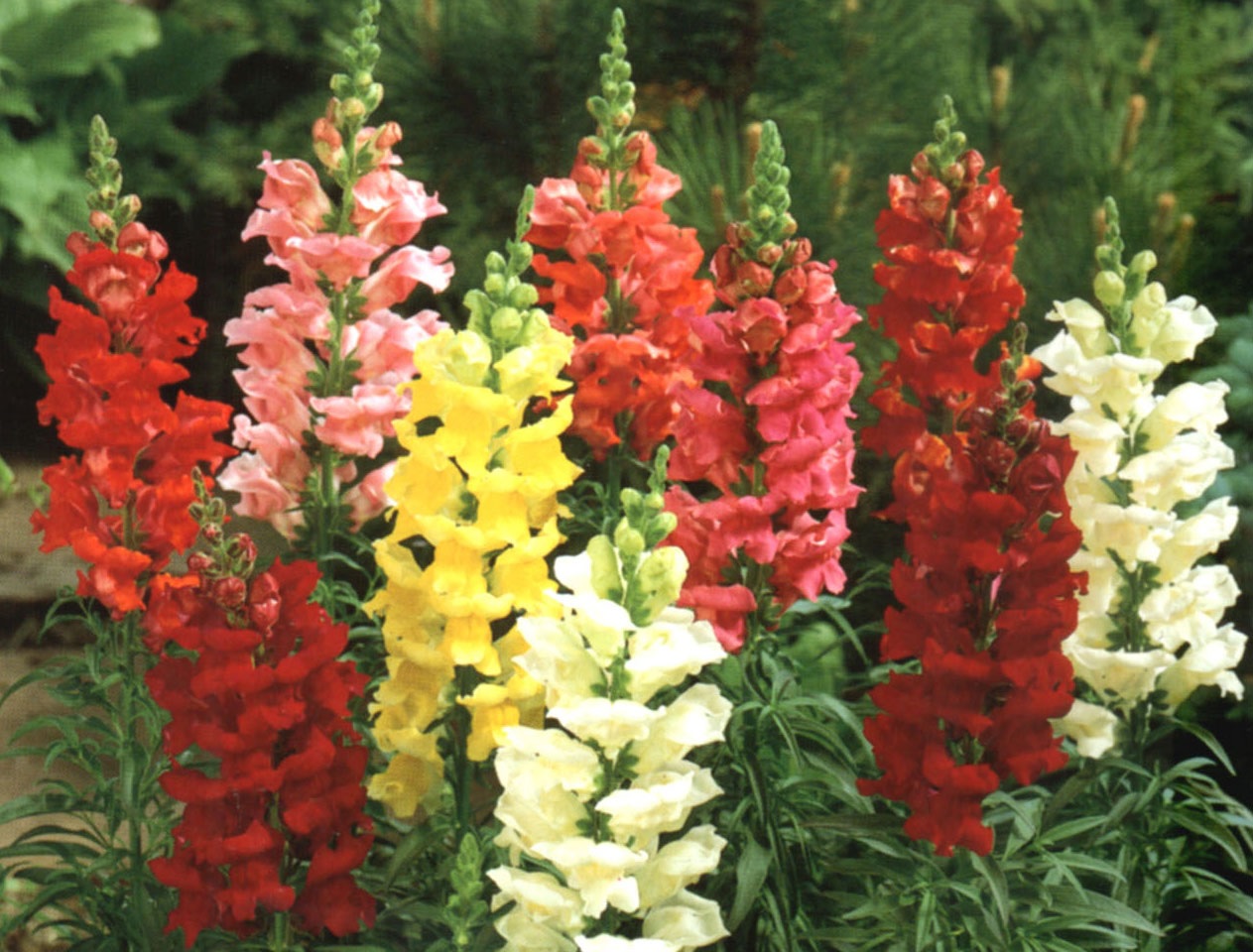How to properly plant snapdragons
Snapdragon seedlings
Depending on the variety you choose, the distance at which the resulting snapdragon seedlings are planted comes. This is done so that there are no unnecessary bald spots or, conversely, excessive thickening of the landing area.
- If you decide to decorate the garden with tall flowers, then they should be located at a distance of about 40-50 cm from each other.
- Medium-sized plants are planted at a distance of about 35 cm.
- Low-growing ones should be placed in the ground, observing a distance between plants of 20 cm.
- For dwarf flowers, 15 cm will be enough.
After sowing the seeds, be sure to loosen the soil, remembering to moisten and feed it. The soil should be neutral or slightly acidic. Also, do not forget about the drainage layer, which is required when planting a snapdragon.
Do not forget that planting is carried out only in the soil, which has been well moistened in advance.
The root of the plant is taproot, so before planting the seedlings, be sure to dig up the soil by about 35 cm.
Prefers to grow in sunny areas, but feels good in partial shade. But it should be borne in mind that if you plant a plant in a shaded place, then its flowering will not be so lush. Water the plant only on dry days.
Snapdragon planting and care
On dry days, water the plant in the morning. At the time of blooming, it is also necessary to moisten the plant.
But, do not overdo it with soil moisture, as stagnant water and watering in the evening can harm your flower.
If you want the flowering to be lush and last for a relatively long time, then you need to:
- Remember to loosen the soil and remove weeds. This procedure is performed in the evening. Remember, the less grass there is near the snapdragon, the less pests and diseases will attack it.
- Tall plant species must be tied up to protect them from bad weather and wind.
- If you want to prolong flowering, then all wilted flowers should be removed. In order to collect seeds from a plant, several flowers must be left in the lower part of it.
- The plant should be fed. The first time you need to apply fertilizer 10-15 days after the completion of planting, using organic matter or nitrophosphate for this. After the appearance of the buds, you need to feed the second time with mineral fertilizers.
What diseases can affect antirrinum
Gray rot, nasty blackleg and septoria blight can attack snapdragons at any time, and you will need special medications to deal with them. First, get rid of all the flowers that have been affected and be sure to treat the soil with antifungal agents.
The main pests that can attack antirrinum are caterpillars, fly larvae, butterflies and scale insects. To get rid of insects, visit a specialty store and purchase an appropriate product.
Planting snapdragon seedlings in open ground: terms and rules
The culmination and the most awaited moment of growing plants is transplanting into a flower bed. For a successful event, you need to know some features.
Transplant timing
The dates for planting seedlings of antirrinum in open ground are late May-early June. In the southern regions, it can be planted in the second half of May, and in colder regions it is better to do this later.
Hardening before disembarkation
Two weeks before planting in open ground, it is necessary to harden the seedlings.For the first week, seedlings should be taken out on a balcony or loggia every day. You need to start with a small time interval, increasing the time spent every day.
In the second week of hardening, the seedlings need to be taken out into the street - first they need to be taken out for half an hour, and then every day the time should be increased and on the last day, on the eve of transplantation, the seedlings of antirrinum should stand in the open air all day. Also, in the early days in the open air, it is necessary for the plants to be in the shade, then you need to gradually bring the plants out into the sun.
Choosing a place and soil for transplanting
For growing flowers outdoors, it is recommended to choose places that are protected from cold winds and drafts. You can plant a light-loving plant both in a well-lit place and in a garden bed with a slight shade (however, the flowering may be less lush in the shade).
As for the soil, it is better to transplant the seedlings to an area with loose, light and slightly alkaline soil. If the soil is acidic, then it is recommended to add wood ash or dolomite flour, and if it is too heavy, then sand.
Transplanting seedlings into open ground
To begin with, you should prepare the landing holes in the selected area. The pits should be slightly larger than the volume of the seedling's earthy coma. The distance between the holes in the garden should come from the plant variety:
- if the seedlings are tall varieties, then the gap between the plants is 40-50 centimeters;
- between medium height - 30 centimeters;
- the distance between low and dwarf varieties is 15-20 centimeters.
Before transplanting, you need to water the plants abundantly in 2 hours. And then carefully remove the seedlings of antirrinum and plant them in the hole without destroying the earthy coma, cover them with soil, lightly tamp them and water them well.
Leaving after disembarkation in open ground
If you properly care for the snapdragon after planting in the open ground, you can see a beautiful, lush bloom. In order to properly care for the plant, a number of simple activities should be performed from time to time.
- It is recommended that after planting seedlings in open ground, mulch the bed with peat, straw, sawdust or some other mulching material.
- The plant is very demanding for watering. Moisture should be added as the top layer of the soil dries. The frequency of watering the antirrinum depends on the weather conditions. It is best to water the flowers in the morning. Do not allow the beds with snapdragons to dry out and waterlogged.
- Every time after watering, it is recommended to loosen the soil around the plants. Manipulation will improve the structure of the soil, optimize air and moisture exchange. It is recommended to loosen it superficially so as not to damage the delicate roots of the plant.
- When the flower has faded, you can collect the inflorescences in order to use the seeds in the future and repeat the cycle by sowing them on seedlings. Photo of lion-like seed pods of snapdragons:
- Top dressing will help you get a beautiful, lush snapdragon bloom. It is best to use mineral complex preparations, as in the case of feeding seedlings, it is optimal to use the drug Nitroammofosk.
- We must not forget about weeding the beds. The presence of weeds among antirrinums is highly undesirable. Remove weeds as they appear.
Video: features of the care of antirrinums.
Few of the summer residents and gardeners will agree to dispute the following fact - this flower is unusually beautiful, they can decorate any site and flower bed. But in order to enjoy the luxurious flowering, you need to plant seedlings in advance (in January, February or March) at home. With knowledge of certain technologies and tricks, even a novice summer resident can cope with the cultivation of antirrinum from seeds.
Getting plants from seeds
To get high-quality seedlings on your own, you need not only to take into account the sowing time, but also to properly prepare the planting material.The unpretentiousness of the plant is an undoubted plus and greatly facilitates the task of flower growers. Therefore, you do not have to spend time and effort on preparing a nutritious soil mixture, as well as creating any special conditions for seedlings.
However, do not think that the seedlings do not need to be left at all. Still, you have to take into account some of the needs of the antirrinum and try to provide it with everything you need.
Hydrangea plant paniculata in Siberia: planting and care
Sowing seeds for seedlings should be done in April or early May. First you need to prepare all the necessary materials and tools:
- Choose a variety and purchase suitable seeds from a flower shop.
- Soil for planting. A light and loose substrate will do.
- A container (for example, a wooden or plastic box).
- Sieve and spatula.
You can now start planting the snapdragon seed.
Agricultural technology of cultivation
Sowing can be carried out in separate pots and pots or in a common wooden box. Choose the option that seems convenient. Once you've decided on your seedling container, you can start planting snapdragon seeds:
- The soil is poured into the container and leveled.
- Planting material is sown densely, but so that in the future the plants do not sprout too densely.
- Then lightly press on the seeds so that they enter the soil and cover them with earth. A sieve is useful here - with it you can get a light and thin layer of soil, which will allow the seedlings to quickly break through to the surface.
- The next item is watering the plantings with clean, settled water. This is best done with a spray bottle. This will only slightly moisten the ground, without washing off the thin top layer of soil from the seeds.
- The container with landings is placed in a plastic bag or covered with a piece of glass or film on top. This kind of greenhouse will help provide plants with the necessary microclimate.
- In order for the sprouts to hatch faster, the container is placed in a warm place. A favorable temperature for seedlings is considered to be 20-23 degrees above zero.
- Also, plantings need diffused, soft sunlight. For this, the southern window is curtained with thin gauze and the box is transferred to the windowsill.
- After about 2 weeks, the first shoots will appear. From this point on, the planting should be ventilated, so you need to clean the greenhouse for a while. To harden the seedlings, the greenhouse absence time is gradually increased. After a while, it can be removed permanently.
Seedling care
Small sprouts need to be watered regularly. Antirrinum is very fond of water, so there is no need to take long breaks between soil moisture. After about two months, in favorable conditions and with good care, the plants will give the first true leaves. After that, the seedlings should be transplanted in separate containers.
The pick must be done very carefully to avoid damage to the root system.
After the pick, it is time to pinch the tops of the plants. To do this, wait until they reach 10 centimeters in height.
Such a procedure is necessary for the rapid emergence and development of lateral shoots, and this is an important condition for the lush flowering of adult antirrinums.
Transplant to open ground
Transplanting young plants into open ground should be carried out when warm weather sets in, and the likelihood of a return of night frosts is zero. By this time, the seedlings will grow up enough and will look like small bushes.
Nemophila in a flower bed: growing from seeds, planting and care
A sunny place is allocated for a flower bed for antirrinums. Also, the flowers will feel good in partial shade.
Antirrinums like loose and light earth. A fertile slightly alkaline soil is perfect, a different acidity of the soil can lead to the fact that the roots of plants will develop poorly.
The problem of too heavy soil is very easy to solve on your own, for this it is enough to mix it with ash, river sand or dolomite flour.Before planting seedlings on a flower bed, mineral fertilizing is introduced into the ground, consisting of nitrogen, potassium and phosphorus.
Small holes are dug under the plants, and then antirrinums are transferred into them by transferring them along with old earthen clods. Depending on the type of flowers, the following distance is left between the planting pits:
- tall varieties - 45 centimeters;
- medium - 30 cm;
- undersized - 20 centimeters;
- dwarf will be enough 15 cm.
After planting, water the plants abundantly and cover the flower bed with peat.
Flower garden care
 If the young shoots of our pet are very tender, then the already grown seedlings after transplanting into the garden are completely undemanding to the conditions and require minimal care. It is usual: timely watering (only as the soil dries up), rare top dressing, loosening the soil and removing weeds. Top dressing is applied 10-15 days after landing in the garden, and then - just before the opening of the buds. They use, for example, azofoska or special flower fertilizers. In addition, tall varieties are sometimes tied to supports.
If the young shoots of our pet are very tender, then the already grown seedlings after transplanting into the garden are completely undemanding to the conditions and require minimal care. It is usual: timely watering (only as the soil dries up), rare top dressing, loosening the soil and removing weeds. Top dressing is applied 10-15 days after landing in the garden, and then - just before the opening of the buds. They use, for example, azofoska or special flower fertilizers. In addition, tall varieties are sometimes tied to supports.
If they do not want to get seeds, after the first shoots have flowered, they are removed, which prolongs flowering for a long time. It is necessary to cut out the entire arrow entirely, with the lowest wilting flower, otherwise new shoots may not form.
This flower gets sick in a flower bed very rarely, only under adverse weather conditions or an unprecedented invasion of any infections. Therefore, flower growers almost never even carry out preventive spraying, and in case of any trouble, they look for recommendations for treatment in special literature.
Sowing seeds for seedlings
As with most garden flowers, growing from seeds is used in the case of snapdragons. When to plant it in a garden bed depends on climatic conditions and the ability to get seedlings: in the southern regions, direct sowing of seeds in open ground is possible, and in the central and northern regions, seedlings of this flower are usually grown on a windowsill or in a greenhouse. Sowing seeds in the south in a garden bed can be carried out not only in spring (in mid-March), but even before winter, however, from a seedless method, flowering can be expected only not earlier than mid-summer.
At home, sowing seeds for seedlings is carried out from late February to mid-March. Since the seedlings still have to dive, you can sow in any small box or box. They do it like this:
- The soil is poured into the selected container with a layer of 5-7 cm. The soil can be a mixture of garden soil with sand (1: 1) or a ready-made soil mixture for flowers bought in a store. It is advisable to place a centimeter layer of drainage under the ground, or at least make holes in the bottom to drain excess water.
- Since the seeds are very small, it is advisable to mix them with sand before sowing (about 1:10), otherwise they will rise with such a brush that it will be very difficult to thin out.
- Seeds are not buried in the ground, they are sown superficially. It is as if the soil is salted with a mixture of seeds and sand.
- Since it is only the beginning of spring in the yard, snow can be easily found. The sown seeds are covered with a good layer of snow and allowed to melt freely; when melting, it will slightly tighten the seeds into the ground, by a fraction of a millimeter, and more is not needed.
- Cover the container with glass and put it in a bright place at room temperature, wait for seedlings. They can appear within five days, but most often it takes from one and a half to two weeks.
As soon as bluish loops appear on the surface, the temperature should be reduced to about 16 ° C: if this is not done, the loops will not only quickly open and turn into seedlings, but also stretch out in just a couple of days, and the seedlings will be unusable. It will be possible to return the temperature to room temperature in five days.
Landing in open ground
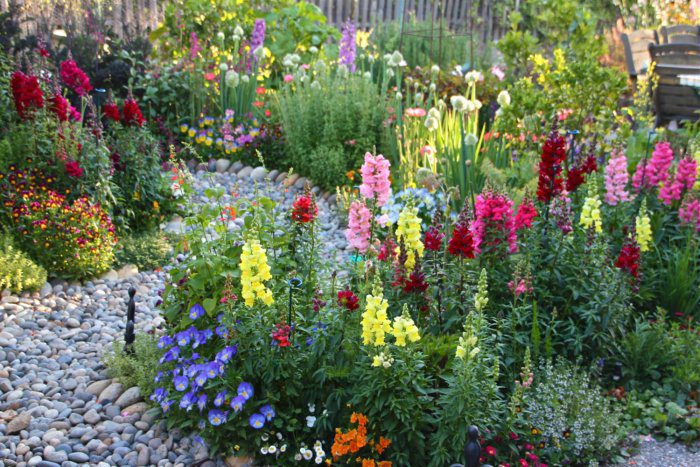
When to plant snapdragons
Snapdragon seedlings should be planted in the last days of May and the first in June.At the same time, you should not be afraid of cold snaps at night, since these plants tolerate them quite calmly. These flowers can be planted both in a sunny area and in a shaded area, but it is worth considering that it must be protected from gusts of wind, and also be well drained. A suitable substrate should be light and rich in nutrients. A mixture consisting of compost, sand, and peat, which are taken in equal proportions, is best suited for growing such a flower. The acidity of the soil should be pH 6-8.
How to plant
The distance between the bushes during planting depends on the variety of snapdragons. So, between dwarf varieties there should be a distance of 15 centimeters, between undersized varieties - about 20 centimeters, between medium-sized ones - 30 centimeters, and between tall ones - from 40 to 50 centimeters. After the bush transplanted into open ground takes root, it grows rather quickly and becomes a spectacular flowering plant. It must be remembered that it is necessary to plant seedlings in a well-watered soil in advance.
Snapdragon. How best to sow, how to properly care.
Growing seedlings
Soil selection
The soil should be light and loose. You can buy a ready-made composition in a specialized store. Self-preparation of the nutritional composition is also allowed. In this case, sod land, sand and peat are mixed in equal parts. Then put a little humus and wood ash into the resulting mixture.
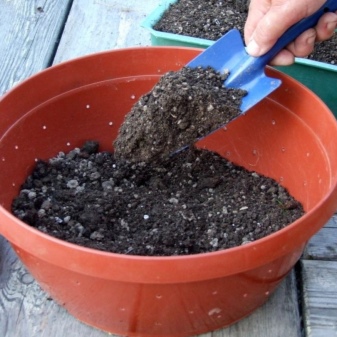
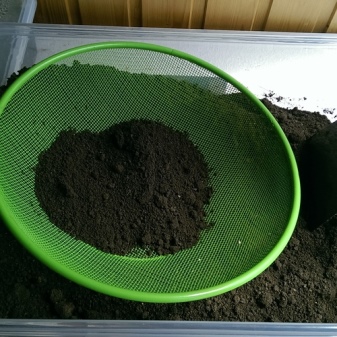
Seed preparation
When choosing seed material in the store, consider the necessary characteristics (height, flowering period). For many, the color of the culture is also important. You can collect the seeds yourself. In this case, the seeds are dried, folded into a bag and placed in the refrigerator. The best place would be the bottom shelf. There the planting material is stored until spring.
Before direct planting, the seeds are disinfected. To do this, use a weak solution of manganese. A half-hour soaking is enough. Then the seeds are removed and laid out on a napkin. Only after complete drying do they start sowing.


Sowing
The snapdragon container must be high enough. The minimum allowable figure is 10 cm. Holes must be made in the bottom of the container to drain excess water.
First, a drain is placed in the container. You can use expanded clay, vermiculite, small stones. A nutritious soil mixture is laid on top of the drainage layer. For disinfection purposes, the soil is spilled with a light manganese solution. Then the container is left for two days. Only after that do they start sowing.

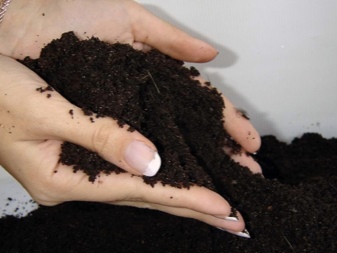
The seed is mixed with clean sand and placed in a paper envelope with the edge cut off. This will distribute the seeds more evenly over the surface. Small grooves are made in the soil. A distance of 2 cm must be observed between the rows.
After sowing, the seeds are gently pressed to the ground. Sand and fertile soil are poured on top in a thin layer. Then the plantings are sprayed from a fine spray gun. After that, the container is covered with foil and placed in a bright place. The optimum temperature level is 18-20 C. Periodically, the film is raised so that future flowers are aired. When topsoil dries up, moisturizes.
Seedling content
When sprouts appear, the shelter is removed. Do it gradually. They start with long airings, each day increasing the time by 15 minutes. After 3 weeks, you will be able to see the first leaves. When two pairs of leaves appear on each sprout, a pick is made.
Young plants are planted in peat cups. Ordinary containers can also be used. The diameter of each container should not be less than 8 cm. If one large box is selected, planting is carried out according to the 5x5 cm scheme. When the movement of the shoots is completed, the soil must be watered.
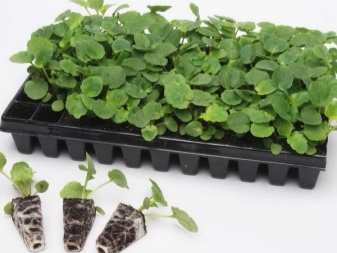
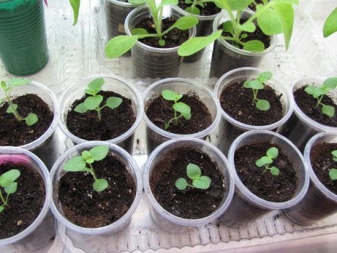
This procedure increases the bushiness of flowers. Also for this purpose, pinch the tops of the seedlings.If young flowers have been moved to a common container, then after a while they will need to be transplanted again. At the second pick, the distance between the specimens should be already 10 cm.
Moisturizing should be regular but moderate. Excess moisture can lead to disease. If a suspicious plaque has appeared on the ground, it is urgent to process it. To do this, dissolve 10 drops of "Fitosporin" in one liter of water. The procedure can be completed by distributing crushed charcoal over the soil surface.

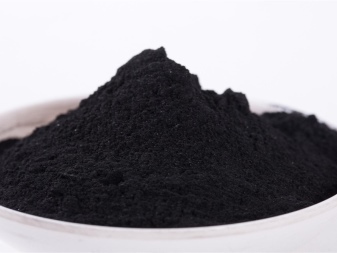
Description
Snapdragon is a perennial plant of the Plantain family. The botanical name antirrinum is associated with the shape of the flowers: translated from Greek it means "nasal". Due to their appearance, the flowers began to be called snapdragons (they resemble the mouth of an animal).

Multicolored garden antirrinums
The genus has about 50 species that grow in the wild as perennials and grown as annuals in gardens.
Snapdragon is native to North America, from where it was brought to the gardens of Russia and Europe.
Herbaceous or shrubby antirrinums have large green stems with grooves and lanceolate or elongated oval leaves. Closer to the inflorescence, the leaf plates grow in the next order, below - the opposite arrangement.
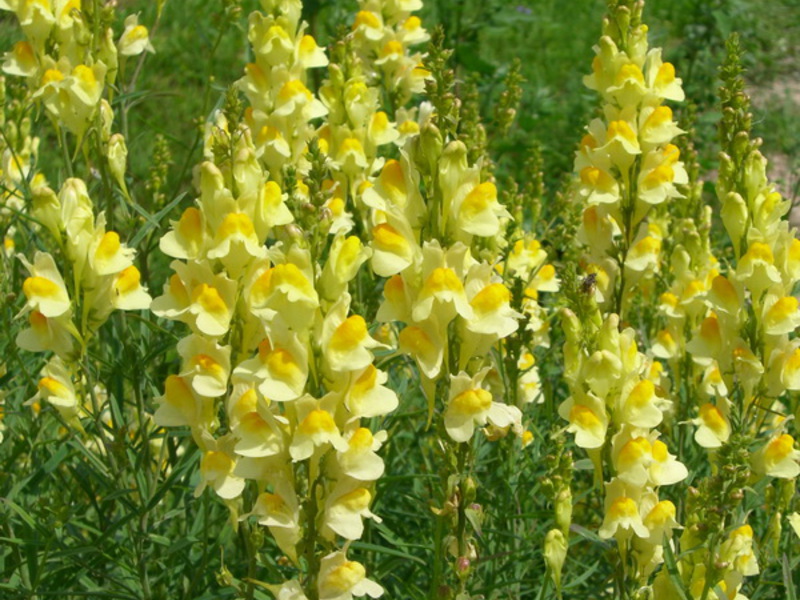
Field antirrinum
Antirrinum bloom begins in May-August. The duration depends on the variety: from 50 to 150 days or longer. Based on the time of appearance of inflorescences, the varieties are divided into the following:
- early: flowering begins in May;
- medium terms: first flowers appear in July;
- late: inflorescences can be seen in early August.
Simple and double snapdragon flowers have a variegated color: yellow, pink, white, purple, red, orange, brown, burgundy, etc. (they are two-colored).
Depending on the variety, flowers are:
- two-lipped irregular shape: short petals form the "upper lip", long - "lower";
- symmetrical; open, tubular, consisting of 5 petals;
- tubular closed;
- two-flowered.
The spike-shaped inflorescence consists of 5-50 flowers, the size of which varies from 2.5 to 5 cm. In total, the plant can form 20-40 inflorescences.
The height of the plants is 15-100 cm. Depending on the size, they are distinguished:
- Dwarf flowers (15-20 cm), popular as a potted plant for decorating terraces, loggias. They are planted in flower beds.
- Low bushes (20-35 cm) are compact. They are planted in flower beds, used as natural borders. There are ampelous varieties.
- Medium bushes (35-60 cm) are used in landscaping to create bouquets. Planted in the garden AND grown as hedges and curbs.
- High (60-80 cm) have a pyramidal shape, since the central stem is higher than the lateral shoots. Most often grown for cutting into bouquets.
- Giant ones (above 80 cm) are planted in flower beds, independently or in the vicinity of other flowers, for example, tulips.

Tall rose bushes of antirrinum
Snapdragon large in the wild is found in southwestern Europe and the Mediterranean countries, as a short-lived perennial. Height, kind about 80-90 cm high. And varieties from 20 cm to 1 meter. Flowering period, blooms from late June to autumn. The cultivars begin to bloom approximately 10 weeks after sowing. The color of the flower, the species has purple-red flowers, the varieties have white, yellow, orange, pink and red different shades, sometimes with a multi-colored pharynx or completely spotted. A place that grows well in sunny and slightly shaded areas.
How to properly plant snapdragons
Snapdragon seedlings
Depending on the variety you choose, the distance at which the resulting snapdragon seedlings are planted comes. This is done so that there are no unnecessary bald spots or, conversely, excessive thickening of the landing area.
- If you decide to decorate the garden with tall flowers, then they should be located at a distance of about 40-50 cm from each other.
- Medium-sized plants are planted at a distance of about 35 cm.
- Low-growing ones should be placed in the ground, observing a distance between plants of 20 cm.
- For dwarf flowers, 15 cm will be enough.
After sowing the seeds, be sure to loosen the soil, remembering to moisten and feed it. The soil should be neutral or slightly acidic. Also, do not forget about the drainage layer, which is required when planting a snapdragon.
Do not forget that planting is carried out only in the soil, which has been well moistened in advance.
The root of the plant is taproot, so before planting the seedlings, be sure to dig up the soil by about 35 cm.
Prefers to grow in sunny areas, but feels good in partial shade. But it should be borne in mind that if you plant a plant in a shaded place, then its flowering will not be so lush. Water the plant only on dry days.
Snapdragon planting and care
On dry days, water the plant in the morning. At the time of blooming, it is also necessary to moisten the plant.
But, do not overdo it with soil moisture, as stagnant water and watering in the evening can harm your flower.
If you want the flowering to be lush and last for a relatively long time, then you need to:
- Remember to loosen the soil and remove weeds. This procedure is performed in the evening. Remember, the less grass there is near the snapdragon, the less pests and diseases will attack it.
- Tall plant species must be tied up to protect them from bad weather and wind.
- If you want to prolong flowering, then all wilted flowers should be removed. In order to collect seeds from a plant, several flowers must be left in the lower part of it.
- The plant should be fed. The first time you need to apply fertilizer 10-15 days after the completion of planting, using organic matter or nitrophosphate for this. After the appearance of the buds, you need to feed the second time with mineral fertilizers.
What diseases can affect antirrinum
Gray rot, nasty blackleg and septoria blight can attack snapdragons at any time, and you will need special medications to deal with them. First, get rid of all the flowers that have been affected and be sure to treat the soil with antifungal agents.
The main pests that can attack antirrinum are caterpillars, fly larvae, butterflies and scale insects. To get rid of insects, visit a specialty store and purchase an appropriate product.


